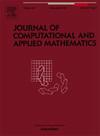具有切比雪夫横坐标的切比雪夫权函数的非对称积积分规则
IF 2.1
2区 数学
Q1 MATHEMATICS, APPLIED
Journal of Computational and Applied Mathematics
Pub Date : 2025-04-02
DOI:10.1016/j.cam.2025.116668
引用次数: 0
摘要
我们研究了四种积积分规则,其中两种是基于第三类或第四类切比雪夫曲线的第一类切比雪夫权值积积分规则,另两种是基于第三类或第四类切比雪夫曲线的第二类切比雪夫权值积积分规则。通过显式公式证明了新规则具有正权重。在此基础上,确定了正交公式的精确程度,计算了正交公式的方差,检验了正交公式的确定性和非确定性,并利用Peano核方法得到了这些公式的渐近最优误差界。此外,证明了积分公式的收敛性,不仅适用于[−1,1]上的黎曼可积函数,而且适用于在[−1,1]的一个或两个端点上具有单调奇异的函数。有趣的是,基于第三类或第四类切比雪夫横轴的第二类切比雪夫权值规则对于非高斯类型的插值公式具有最好的精确度。本文章由计算机程序翻译,如有差异,请以英文原文为准。
Nonsymmetric product integration rules for Chebyshev weight functions with Chebyshev abscissae
We study four product integration rules, two for the Chebyshev weight of the first-kind based on the Chebyshev abscissae of the third or fourth-kind, and another two for the Chebyshev weight of the second-kind based again on the Chebyshev abscissae of the third or fourth-kind. The new rules are shown to have positive weights given by explicit formulae. Furthermore, we determine the precise degree of exactness and we compute the variance of the quadrature formulae, we examine their definiteness or nondefiniteness, and we obtain asymptotically optimal error bounds for these formulae by Peano kernel methods. In addition, the convergence of the quadrature formulae is shown not only for Riemann integrable functions on , but also for functions having a monotonic singularity at one or both endpoints of . Interestingly enough, the rules for the Chebyshev weight of the second-kind based on the Chebyshev abscissae of the third or fourth-kind have the best possible degree of exactness for an interpolatory formula not of Gauss type.
求助全文
通过发布文献求助,成功后即可免费获取论文全文。
去求助
来源期刊
CiteScore
5.40
自引率
4.20%
发文量
437
审稿时长
3.0 months
期刊介绍:
The Journal of Computational and Applied Mathematics publishes original papers of high scientific value in all areas of computational and applied mathematics. The main interest of the Journal is in papers that describe and analyze new computational techniques for solving scientific or engineering problems. Also the improved analysis, including the effectiveness and applicability, of existing methods and algorithms is of importance. The computational efficiency (e.g. the convergence, stability, accuracy, ...) should be proved and illustrated by nontrivial numerical examples. Papers describing only variants of existing methods, without adding significant new computational properties are not of interest.
The audience consists of: applied mathematicians, numerical analysts, computational scientists and engineers.

 求助内容:
求助内容: 应助结果提醒方式:
应助结果提醒方式:


